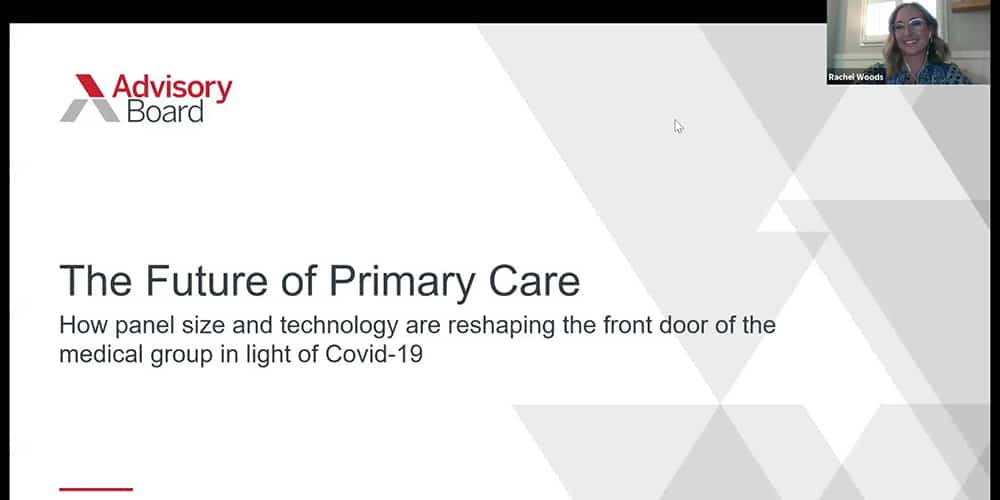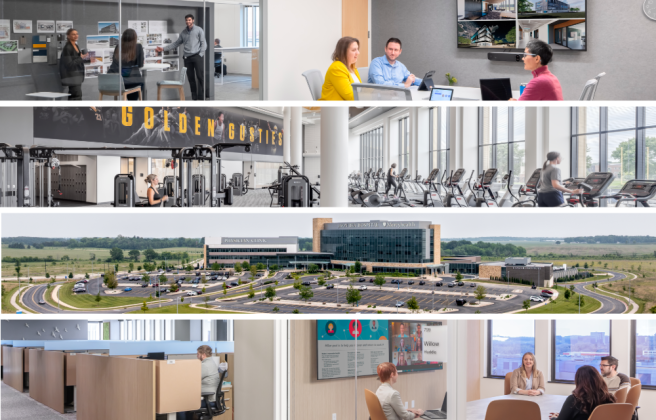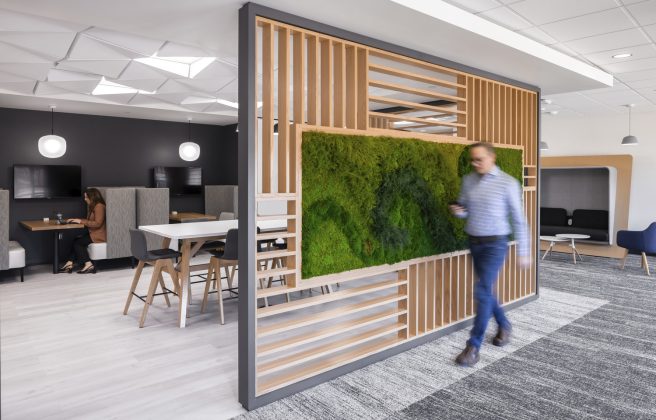Rachel Woods stated it succinctly: Primary care is primed for disruption.
And that was before COVID-19 hit the United States and forced so many clinics and organizations providing primary care into crisis operations.
Still, in an environment that is dramatically different in July 2020 compared to January 2020, Woods outlined a future for primary care that showed how the practice could respond to changing consumer demands and needs, physician burnout, and technical disruptions to both improve the quality of care provided and expand provider’s ability to deliver that care.
In the first BWBR Live Talk, Woods’s presentation on the future of primary care provided a balanced call-to-action with a sense of excitement that technological advances are bringing to the practice of primary care. While referencing the pressures primary care faces from payers, patient needs and expectations, and dwindling physician ranks, the senior director from the Advisory Board leaned into the innovative ideas infiltrating primary care operations to argue there is a robust role for primary care in coming years.
“A focus on primary care must be an integral part of [an organization’s] strategic plan,” Woods said at the beginning of her presentation. She then followed that up: “The primary care industry has practically demanded to be disrupted, and the disruptors have come in droves.”
More than a critique, Woods leveraged that idea of disruption to showcase examples of how organizations are evolving their business models to improve the outcomes of the care they provide while also alleviating the pressures that physicians currently encounter delivering that care. Responding to the historic challenges of access and affordability – affecting the treatment of increasing patient morbidity and physician compensation – Woods argued that narrowing a scope of practice and implementing a technology strategy to increase the scale of the population reach is where many clinics could be focusing their efforts.
“The goal here is, while panel size might be your operational indicator, you want to ground yourself in the seesaw of the patient need and the physician desire.”
Rachel Woods, Advisory Board
“If you only remember two words, I want it to be ‘scope’ and ‘scale,’” she said. “Organizations must leave behind the old one-size-fits-all primary care model. If we are honest with ourselves, we know that it wasn’t actually working before COVID hit, and its inefficiencies themselves pretty dramatically in the face of a pandemic.”
By focusing on a subset of a patient population – for example, seniors, high-risk patients, or sports medicine – organizations have demonstrated they can improve patient outcomes, lower the treatment costs, and increase physician job satisfaction by giving them more care support with the wrap-around services that the patient’s needs require.
Key to the success of the scoped model is defining the panel size for providers. In some practices focusing on higher risk patients, this can be between 400-500 patients per physician, down from an average of 2,000 general patients. In practices whose scope is on patients who want more on-demand access and are willing to pay, the decrease in panel size is much less significant, with patients who have less chronic needs and are healthier, in general.
Leaning into the critique that narrowing a scope of practice could decrease access to care, Woods explained how a scoped practice can increase care because of the specialization of the care offered, giving physicians an opportunity to self-select into a more amenable practice but also expanding the team that provides the care, from physician assistants to nurse practitioners, dieticians, therapists, and more.
In one example, Johns Hopkins demonstrated how a shift to a high-risk, high-touch interventional clinic that reduced panel sizes to 90 patients per provider improved access and outcomes. The model reduced emergency department visits by 60 percent, saved $15 million in treatment costs, and allowed the patient to move into a more traditional primary care practice in eight months.
“The benefit of specialization in primary care is that it gives physicians the support structure they need to treat the specific population they serve,” she said.
Paired with technology solutions from telehealth to artificial intelligence, Woods then showed how clinics could scale their practice to serve the needs of their communities. “Telehealth is not a strategy. It is a way to enable an existing strategy at your organization…[F]irst understand what’s the business goal that is going to be supported by telehealth, and then how can I scale that across my organization.”
She added: “Telehealth on its own might not actually get you that scale, especially if it’s seen as a replacement. You might shave off some minutes here and there. What we’re really talking about if we’re going to generate scale is how do I dramatically increase my panel size by utilizing technology to streamline the administrative and clinical burden of the workflow.”
Examples of such technological integrations ranged from ambient listing devices that automate medical record inputs to back-end platforms streamlining patient referrals to artificial intelligence that could screen patients and outline diagnosis for physicians to review, affirm, or modify. Woods showed how such technological innovations streamline operations to both improve the workload for physicians, improve patient diagnosis, and increase a clinic’s capacity to serve patients.
“Giving minutes back in a physician’s day not only gives them a break from the admin burden of medicine, but it also generates some efficiency and scale in their workflow.”
“Technology can enable our existing visit models to generate real scale,” Woods said. “The goal here is, while panel size might be your operational indicator, you want to ground yourself in the seesaw of the patient need and the physician desire.”








